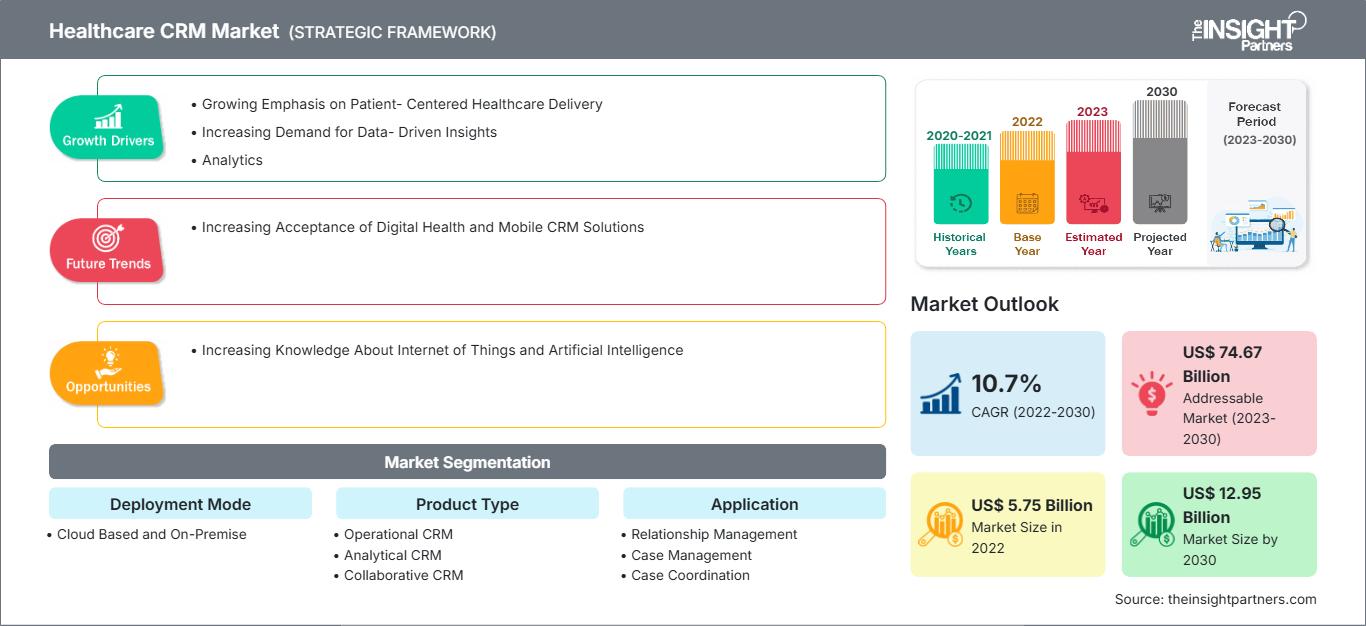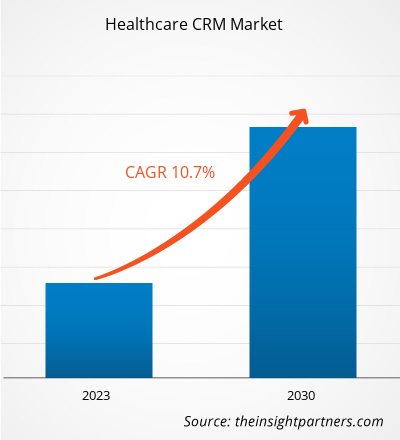[調査レポート] 医療 CRM の市場価値は、2022 年の 57 億 5,095 万米ドルから 2030 年には 129 億 4,715 万米ドルに拡大し、2022 年から 2030 年にかけて 10.7% の CAGR で成長すると予測されています。
市場の洞察とアナリストの見解:
医療 CRM は、医療サービス プロバイダーが医療セキュリティ基準を遵守しながら、患者情報を保存および管理し、サービスとエンゲージメントを向上させ、患者獲得戦略を改善し、マーケティングおよび販売業務を自動化することを支援する業界固有のシステムです。医療 CRM 市場の成長を牽引する主な要因には、患者中心の医療提供への重点が高まっていることと、データ主導の洞察、分析、および集団健康管理に対する需要の増加が含まれます。ただし、データ セキュリティの欠如と患者情報のプライバシーに関する懸念が、医療 CRM 市場の成長を妨げています。
成長の原動力と抑制要因:
医療システムにおける患者中心のアプローチは、患者、その家族、医療従事者の間でパートナーシップを構築し、患者のニーズ、嗜好、要望に沿った意思決定を可能にします。また、患者が特定の決定を下し、ケアに参加できるように、患者への特別な教育とサポートの提供も含まれます。
すべての関係者(医療提供者、患者、その他)との連携強化は、全体的な経費を削減します。さらに、患者の健康、幸福、医療選択に関する知識と理解の向上は、ケアの向上と疾病レベルの低減につながります。この知識の向上は、退院後のケア、入院、再入院の減少、二次相談の促進につながります。医療提供者は、意思決定において患者と連携し協力することで、患者の健康に関するより適切な意思決定を行うことができます。また、ケアの質とコストの両方に基づいて患者獲得を競う病院が増えるにつれて、競争上の優位性も高まります。患者の生活の質が向上すると、医師と患者の両方の満足度が向上します。
要件に合わせてレポートをカスタマイズ
レポートの一部、国レベルの分析、Excelデータパックなどを含め、スタートアップ&大学向けに特別オファーや割引もご利用いただけます(無償)
ヘルスケアCRM市場: 戦略的洞察

-
このレポートの主要な市場動向を入手してください。この無料サンプルには、市場動向から見積もりや予測に至るまでのデータ分析が含まれます。
医療業界の変革には、技術革新とソフトウェア開発が不可欠です。これらの技術開発は、医療プロセス、コミュニケーション、ワークフローを劇的に強化・簡素化する医療・管理サービスをサポートしています。患者中心の医療は患者満足度を高め、医療提供者と医療現場に利益をもたらします。そのため、医療提供者による患者中心のアプローチの採用が増えていることが、医療CRM市場の成長を牽引しています。
しかし、CRMポータルに保存される機密性の高い医療データの保護は、医療提供者とケアを受ける人々にとって大きな懸念事項です。CRMを操作するエンドユーザーが個人データを第三者に販売する可能性があるため、患者は生体データを含む可能性のある個人データのプライバシーを懸念しています。さらに、これらのデバイスが患者の医療請求記録に接続されている場合、リスクはさらに金融データ漏洩につながる可能性があります。HIPAAジャーナルによると、2009年から2022年の間に、500件を超える記録に関する5,150件の医療データ漏洩がHHSの公民権局に報告されています。これらの侵害により、3億8,226万2,109件の医療記録が露出または不当に開示されました。これは米国の人口の1.2倍以上に相当します。2022年には、500件以上の医療記録に関するデータ侵害が1日平均1.94件報告されました。テクノロジー企業が自社製品のセキュリティ強化に多額の投資を行っているにもかかわらず、消費者が医療関連の活動にソフトウェアに完全に依存するにはしばらく時間がかかる可能性があります。そのため、データセキュリティとプライバシーに関する問題がCRMソフトウェアの採用を制限し、市場の成長を妨げています。
トレンド:
医療分野でデジタルヘルスとモバイル顧客関係管理 (CRM) ソリューションを受け入れる傾向が高まっており、医療CRMの状況が再形成され、患者エンゲージメント、仮想医療提供、モバイルケアコーディネーションを合理化する革新的なプラットフォームの需要が高まっています。デジタルヘルスの普及により、医療業界はデジタルチャネル、モバイル技術、強化された患者エクスペリエンスを活用して、ケアの提供と患者満足度を最適化できるようになります。
医療インフラにおけるデジタルヘルスの普及は、ケアコーディネートツール、安全なメッセージングプラットフォーム、リモートケアコーディネート機能の統合に影響を与え、マルチチャネルのケアインタラクションのサポート、医師と患者のコミュニケーションの促進、多様なタッチポイントを通じた患者エンゲージメントの強化につながります。さらに、モバイル技術とアプリケーションの急速な進歩、既存のeHealthサービスにモバイルヘルスを統合する新たな機会、携帯電話ネットワークのカバレッジの継続的な拡大は、モバイルCRMなどのモバイルヘルスケアソリューションの普及を支える主要な要因です。国際電気通信連合(ITU)の推計によると、2020年には50億人以上の無線通信加入者がおり、その70%以上が低所得国および中所得国に居住しています。GSM協会によると、商用無線通信は世界人口の約85%に到達しており、これは電力網の届かない範囲をはるかに超えています。無線通信の普及は、遠隔患者モニタリングや医療スケジュールといった問題への対応を支援するだけで、ケアの質と患者の健康を向上させ、毎年莫大な医療費を節約することにつながります。mHealthの用途は今後数年間で拡大すると予想されます。Salesforceによると、病院の約52%が3つ以上のコネクテッドヘルス技術を使用しており、そのうち58%がモバイル向けに最適化された患者ポータルを使用しています。このように、モバイルヘルスソリューションの用途の増加とデジタルヘルスの世界的な普及により、様々な医療インフラにおける医療CRMの需要が増加するでしょう。
レポートのセグメンテーションと範囲:
世界の医療CRM市場は、導入モード、製品タイプ、アプリケーション、エンドユーザーに基づいてセグメント化されています。導入モードに基づいて、市場はクラウドベースとオンプレミスに分かれています。製品タイプに基づいて、市場は運用CRM、分析CRM、コラボレーティブCRMに分かれています。医療CRM市場は、アプリケーション別に、リレーションシップ管理、ケース管理、ケースコーディネーション、コミュニティアウトリーチなどに分かれています。エンドユーザーの観点から見ると、ヘルスケアCRM市場はプロバイダー、保険者、その他に分類されます。地理的には、北米(米国、カナダ、メキシコ)、欧州(ドイツ、フランス、イタリア、英国、ロシア、その他欧州)、アジア太平洋(オーストラリア、中国、日本、インド、韓国、その他アジア太平洋)、中東・アフリカ(南アフリカ、サウジアラビア、UAE、その他中東・アフリカ)、南米・中米(ブラジル、アルゼンチン、その他南米・中米)に分類されます。
セグメント分析:
導入形態に基づいて、ヘルスケアCRM市場はクラウドベースとオンプレミスに分類されます。クラウドベースのセグメントは2022年に大きな市場シェアを占め、2022年から2030年にかけて市場でより高いCAGRを記録すると予想されています。クラウドベースのヘルスケアCRMソリューションはベンダーのサーバーでホストされ、Webブラウザーからアクセスします。クラウドベースのCRMソリューションは比類のないアクセス性を提供し、医療従事者はインターネット接続があればどこからでも患者データやCRMツールにアクセスできます。この柔軟性は、リモートまたは複数の場所で作業する医療提供者にとって特に価値があります。
ヘルスケアCRM市場は、製品タイプ別に、分析CRM、コラボレーティブCRM、および運用CRMに分類されます。運用CRMセグメントは2022年に最大の市場シェアを占め、2022年から2030年にかけて市場で最高のCAGRを記録すると予想されています。運用CRMは、医療機関内の予約スケジュール、患者登録、請求、請求処理などの運用プロセスの合理化と自動化に重点を置いています。これらのソリューションは、医療提供者の効率性向上、管理負担の軽減、そして患者エクスペリエンス全体の向上に役立ちます。
アプリケーション別に見ると、ヘルスケアCRM市場は、ケースマネジメント、リレーションシップマネジメント、コミュニティアウトリーチ、ケースコーディネーション、その他に分類されています。リレーションシップマネジメントセグメントは2022年に最大の市場シェアを占め、2022年から2030年にかけて市場で最も高いCAGRを記録すると予想されています。ヘルスケアCRM市場におけるリレーションシップマネジメントは、患者、介護者、その他の利害関係者との強固な関係の構築と維持に重点を置いています。
エンドユーザー別に見ると、ヘルスケアCRM市場は、医療提供者、保険支払者、その他に分類されています。プロバイダーセグメントは2022年に最大の市場シェアを占め、2022年から2030年にかけて市場で最高のCAGRを記録すると予想されています。病院、診療所、個々の医療専門家などのプロバイダーは、患者のケースを管理し、ケアを調整し、患者との強力な関係を構築するのに役立つCRMソリューションを必要としています。
地域分析:
地理的に、医療CRM市場は、北米、ヨーロッパ、アジア太平洋、南米および中米、中東およびアフリカに分割されています。2022年には、北米が世界の医療CRM市場で最大のシェアを占めました。アジア太平洋地域は、2022年から2030年の間に最高のCAGRを記録すると予測されています。
米国の病院と診療所の大部分は、財務的および運用上のストレスを経験しています。ヘルスケア CRM ソフトウェアは、主に病院、診療所、外来手術センターで、特に救急部門での予約のスケジュール設定と管理、および外来、入院、手術部門での非効率的なスケジュール設定に使用されます。効率的な患者スケジュール管理は、ほとんどの病院や診療所にとって依然として緊急の課題です。不適切な医療スケジュール設定により、患者は公的および私的医療システムにおいて質の高いケアを受けるのに遅れが生じます。2022 年の医師予約待ち時間とメディケアおよびメディケイド受入率に関する調査によると、医師との初回予約のスケジュール設定には平均 26 日間の待機期間があり、平均待ち時間が約 24 日だった 2017 年から 8% 増加しています。これにより、待ち時間が長くなり、スケジュール設定が困難になり、公的および私的医療部門における需給の不均衡が生じます。ヘルスケア CRM ソフトウェアを使用すると、病院や診療所は患者の来院と退院を追跡し、自己負担額やキャンセルに関する最新情報をリアルタイムで入手できます。ソフトウェアの使用により、予約リマインダーの電話で無断キャンセルが30%削減されます。これにより、治療手順全体が強化され、患者とのコミュニケーションが改善されます。
さらに、米国では慢性疾患と急性疾患の有病率が高いことが報告されています。米国心臓協会の「心臓病と脳卒中の統計 - 2023年最新情報」によると、2020年の米国におけるCVD関連死亡の主な原因(41.2%)は冠動脈性心疾患(CHD)で、次いで脳卒中(17.3%)、その他のCVD(16.8%)、高血圧(12.9%)、心不全(9.2%)、動脈疾患(2.6%)となっています。米国疾病予防管理センター(CDC)によると、米国の20歳以上の成人の約20人に1人が冠動脈疾患を患っています。このように、CVDやその他の慢性疾患の有病率の高さは、米国における医療スケジュール管理とヘルスケアCRMの導入の需要を促進しています。また、米国におけるヘルスケアITの急速な導入は、将来のヘルスケアCRM市場の成長を牽引すると予想されています。
ヘルスケアCRM市場の地域別分析
The Insight Partnersのアナリストは、予測期間を通じてヘルスケアCRM市場に影響を与える地域的なトレンドと要因を詳細に解説しています。このセクションでは、北米、ヨーロッパ、アジア太平洋、中東・アフリカ、中南米におけるヘルスケアCRM市場のセグメントと地域についても解説しています。
ヘルスケアCRM市場レポートの範囲
| レポート属性 | 詳細 |
|---|---|
| の市場規模 2022 | US$ 5.75 Billion |
| 市場規模別 2030 | US$ 12.95 Billion |
| 世界的なCAGR (2022 - 2030) | 10.7% |
| 過去データ | 2020-2021 |
| 予測期間 | 2023-2030 |
| 対象セグメント |
By 展開モード
|
| 対象地域と国 |
北米
|
| 市場リーダーと主要企業の概要 |
|
ヘルスケアCRM市場のプレーヤー密度:ビジネスダイナミクスへの影響を理解する
ヘルスケアCRM市場は、消費者の嗜好の変化、技術の進歩、製品メリットへの認知度の向上といった要因によるエンドユーザーの需要増加に牽引され、急速に成長しています。需要が高まるにつれ、企業は提供内容の拡充、消費者ニーズへの対応のためのイノベーション、そして新たなトレンドの活用を進めており、これが市場の成長をさらに加速させています。

- 入手 ヘルスケアCRM市場 主要プレーヤーの概要
世界のヘルスケア CRM 市場で活動している主要企業によるさまざまな取り組みを以下に示します。
- 2023 年 8 月、IBM と Salesforce は、世界中のさまざまな業界の企業が CRM 向け AI の導入を加速できるよう支援するためのコラボレーションを発表しました。両社は協力して、顧客、パートナー、従業員のエクスペリエンスを変革し、同時にデータの保護を支援します。
- 2022 年 4 月、Cured は、ヘルスケア向けに構築されたデジタル マーケティングおよび顧客関係管理 (CRM) プラットフォームの次世代の進化版のリリースを発表しました。これにより、同社はケアを完全な循環にするという使命をさらに果たせるようになります。これらのプラットフォームの進歩により、ヘルスケア組織は新規顧客や既存患者と比類のない関係を構築できるようになります。
- 2021 年 11 月、Pegasystems Inc は Google Cloud と連携し、より優れたデータ分析情報とパーソナライゼーションによりヘルスケアのエクスペリエンスを向上させました。 Pega と Google Cloud のパートナーシップにより、Google Cloud の Healthcare Data Engine の機能と Pega のインテリジェント ヘルスケア ソリューション スイートが統合されました。
競合状況と主要企業:
Pegasystems Inc、Sage Group Plc、IQVIA Holdings Inc、VerioMed Corp、Pipedrive Inc、WebMD Ignite Inc、Zendesk Inc、SugarCRM Inc、SAP SE、Veeva Systems Inc、Oracle Corp、ScienceSoft USA Corp、Microsoft Corp、Salesforce Inc、International Business Machines Corp は、ヘルスケア CRM 市場で事業を展開する有力企業です。これらの企業は、世界中で高まる消費者需要に対応し、専門分野における製品ラインナップを拡大するために、新技術の導入、既存製品の進化、地理的拡大に注力しています。
- 過去2年間の分析、基準年、CAGRによる予測(7年間)
- PEST分析とSWOT分析
- 市場規模価値/数量 - 世界、地域、国
- 業界と競争環境
- Excel データセット
最新レポート
関連レポート
お客様の声
購入理由
- 情報に基づいた意思決定
- 市場動向の理解
- 競合分析
- 顧客インサイト
- 市場予測
- リスク軽減
- 戦略計画
- 投資の正当性
- 新興市場の特定
- マーケティング戦略の強化
- 業務効率の向上
- 規制動向への対応






















 無料サンプルを入手 - ヘルスケアCRM市場
無料サンプルを入手 - ヘルスケアCRM市場